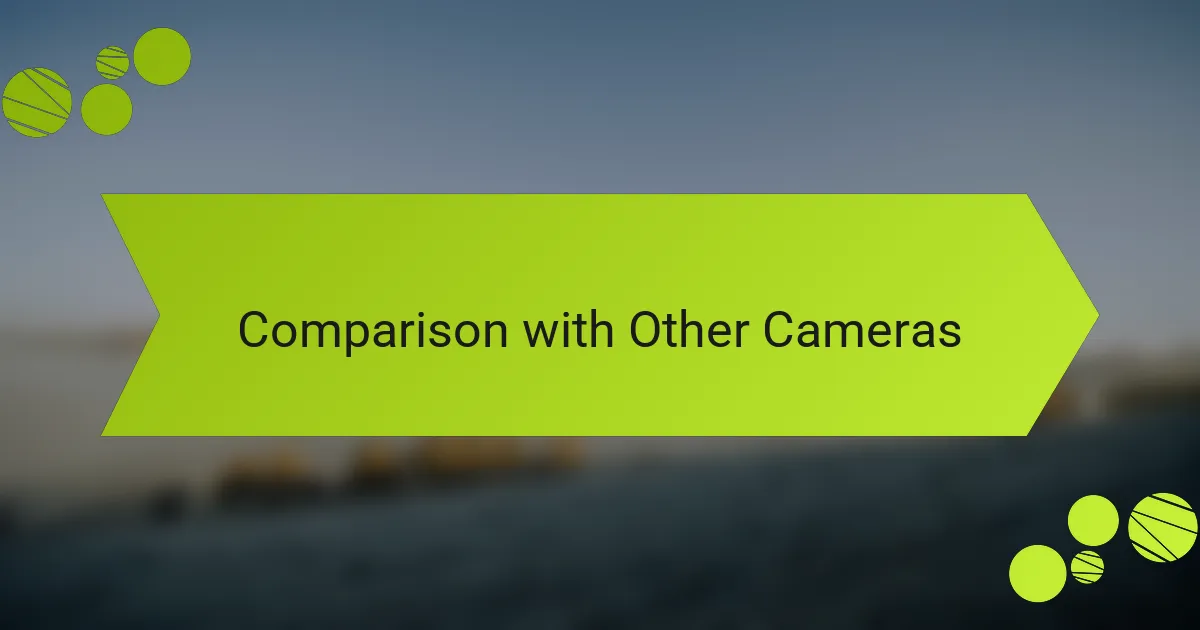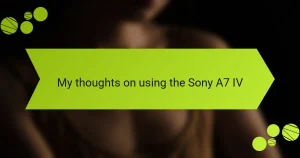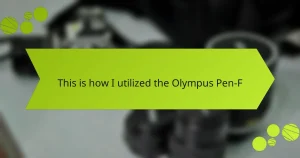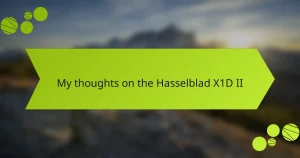Key takeaways
- The Ricoh GR III is a compact camera favored for its portability, making it ideal for street photography and capturing spontaneous moments.
- It features a 24.2-megapixel APS-C sensor and a 28mm f/2.8 lens, offering exceptional image quality even in low light situations.
- Key advantages include quick autofocus, RAW format shooting for flexibility in post-processing, and built-in stabilization to enhance image sharpness.
- Despite its strengths, it lacks a built-in viewfinder and weather sealing, which may be considerations for some users.

Introduction to Ricoh GR III
The Ricoh GR III is a compact camera that has really made its mark among street photographers and enthusiasts alike. I remember the first time I held one; it felt like a perfect blend of design and functionality, truly meant for capturing life as it unfolds. With its 24.2-megapixel APS-C sensor, this camera promises stunning image quality, even in challenging lighting conditions.
What really sets the GR III apart for me is its portable nature. Have you ever been caught without your camera at just the right moment? With this little gem, that’s a worry of the past. I can easily slip it into my pocket, which means I’m always ready to document those spontaneous moments that often pass us by.
Another noteworthy feature is its fast, silent autofocus, ideal for candid shots without drawing attention to myself. I’ve found that this is a game-changer in urban environments where the beauty of a fleeting moment can be missed if you’re not quick enough. The Ricoh GR III is not just a camera; it feels like an extension of my own vision, allowing me to tell stories through my lens.

Overview of Camera Features
One of the standout features of the Ricoh GR III is its impressive 28mm equivalent f/2.8 lens. This wide aperture excels at capturing sharp images while also providing beautiful background blur—a quality that I find essential for highlighting my subjects. In my experience, this lens makes it easy to frame a scene, whether I’m shooting street portraits or bustling cityscapes.
Another aspect I appreciate is its ability to shoot in RAW format, offering incredible flexibility during post-processing. I remember a particularly gray day when I took some shots that, at first glance, lacked vibrancy. However, tweaking those RAW files brought out colors I didn’t initially see. It’s moments like these that remind me of the power of having editing options at my fingertips.
The GR III’s built-in stabilization is also worth mentioning. I often shoot handheld, especially in low-light situations, and I’ve noticed a tremendous difference in the sharpness of my images. It’s almost like having a steady hand even when mine gets a bit shaky from excitement. Have you ever taken a photo that was just slightly off because of camera shake? With the GR III, those worries seem far behind me, allowing me to focus on my creativity rather than technical limitations.

Performance and Image Quality
When it comes to the performance of the Ricoh GR III, I can honestly say it’s impressive for a compact camera. The 24-megapixel APS-C sensor delivers stunning image quality, even in low light situations. I remember taking it on a recent evening stroll, and the colors popped beautifully without any noticeable noise in the shadows.
In terms of autofocus, the GR III has a fast and reliable system that offers multiple modes to suit your shooting style. I found the snap focus feature particularly useful for street photography, as it allows for quick captures without the delay of focusing. The sharpness and detail in the images truly reflect the serious capabilities of this little powerhouse.
Here’s a quick comparison table that highlights some key aspects of the Ricoh GR III’s performance and image quality:
| Feature | Ricoh GR III |
|---|---|
| Sensor Type | 24MP APS-C |
| ISO Range | 100 – 102400 |
| Autofocus Points | On-Sensor Phase Detection, 9 Points |
| Max Shutter Speed | 1/4000 sec |
| Image Stabilization | In-body 3-axis |

Comparison with Other Cameras
When I compare the Ricoh GR III with other compact cameras, one model that comes to mind is the Fujifilm X100V. Both are lightweight and portable, but the Ricoh offers a unique experience with its 28mm equivalent lens, which I adore for street photography. I remember taking the GR III on a spontaneous trip, capturing candid moments effortlessly, while the X100V’s fixed 35mm lens felt a bit limiting in some situations.
Another camera worth mentioning is the Sony RX100 VII. The RX100 series boasts versatility with its zoom capabilities, which is ideal if you want a range of focal lengths in one device. However, I find the GR III’s minimalist approach and excellent image quality to be more appealing for those who appreciate simplicity in design and usability.
| Camera | Key Features |
|---|---|
| Ricoh GR III | 28mm f/2.8 lens, APS-C sensor, compact size, excellent for street photography |
| Fujifilm X100V | 35mm f/2 lens, APS-C sensor, hybrid viewfinder, stylish design |
| Sony RX100 VII | 24-200mm zoom lens, 1-inch sensor, versatile shooting options |

My Personal Experience Using GR III
Using the Ricoh GR III has been a rather delightful experience for me. The moment I picked it up, I was struck by its compact size and lightweight design, which makes it incredibly easy to carry around. Whether I’m exploring city streets or capturing intimate moments at family gatherings, the GR III has become my go-to camera, always reminding me how simplicity can lead to stunning results.
One feature that particularly stands out to me is the camera’s sharp lens. I recall a sunny afternoon when I snapped a photo of a street musician performing. The clarity and vibrancy of the image truly captured the essence of the moment, and I couldn’t help but feel proud to share it. Overall, the GR III melds quality and portability perfectly, making it a joy to use daily.
| Feature | Ricoh GR III |
|---|---|
| Sensor | 24 MP APS-C |
| Lens | 28mm equivalent f/2.8 |
| ISO Range | 100-102400 |
| Battery Life | 200 shots |

Pros and Cons of Ricoh GR III
When I think about the Ricoh GR III, I can’t help but appreciate its compact design paired with phenomenal image quality. The camera’s 24-megapixel APS-C sensor excels in low-light conditions, which I found particularly helpful during my evening walks. However, the lack of a built-in viewfinder can be a downside for some users, like me, who prefer a more traditional shooting experience.
On the flip side, I love how the GR III encourages creativity with its dedicated snap focus feature, allowing for quick, sharp shots without the need to fuss with settings. Yet, the absence of weather sealing makes me a little cautious when I’m out shooting in unpredictable weather. Overall, the pros definitely outweigh the cons, but it’s essential to consider how you’d use this camera in your own photography adventures.
| Pros | Cons |
|---|---|
| Compact and lightweight design | No built-in viewfinder |
| Excellent image quality in low light | Lacks weather sealing |
| Quick snapshot capability | Limited battery life |

Final Thoughts and Recommendations
The Ricoh GR III has truly left a mark on my photographic journey. Its compact size makes it the perfect companion for street photography, capturing fleeting moments with ease. I appreciate its sharp image quality and fast autofocus, which really delivers when I need to snap a shot quickly, especially during busy city walks.
When considering whether this camera suits you, think about your shooting style. If you value portability and the ability to blend into your surroundings without sacrificing image quality, then the GR III may be a fantastic fit. However, if you prefer a more extensive range of lenses or additional manual controls, you might want to explore other options.
Here’s a quick comparison to help you see where the Ricoh GR III stands against other popular compact cameras:
| Feature | Ricoh GR III | Other Compact Cameras |
|---|---|---|
| Sensor | 24MP APS-C | Varies (often smaller sensors) |
| Size | Compact and lightweight | Varies (often bulkier) |
| Image quality | Exceptional in low light | Good, but may lack detail |
| Price | Mid-range | Varies widely |




